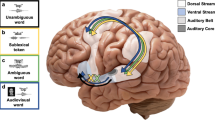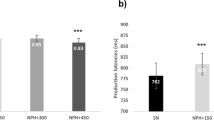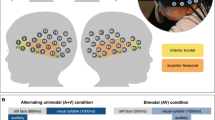Abstract
Auditory phoneme discrimination (APD) is supported by both auditory and motor regions through a sensorimotor interface embedded in a fronto-temporo-parietal cortical network. However, the specific spatiotemporal organization of this network during APD with respect to different types of phonemic contrasts is still unclear. Here, we use source reconstruction, applied to event-related potentials in a group of 47 participants, to uncover a potential spatiotemporal differentiation in these brain regions during a passive and active APD task with respect to place of articulation (PoA), voicing and manner of articulation (MoA). Results demonstrate that in an early stage (50–110 ms), auditory, motor and sensorimotor regions elicit more activation during the passive and active APD task with MoA and active APD task with voicing compared to PoA. In a later stage (130–175 ms), the same auditory and motor regions elicit more activation during the APD task with PoA compared to MoA and voicing, yet only in the active condition, implying important timing differences. Degree of attention influences a frontal network during the APD task with PoA, whereas auditory regions are more affected during the APD task with MoA and voicing. Based on these findings, it can be carefully suggested that APD is supported by the integration of early activation of auditory-acoustic properties in superior temporal regions, more perpetuated for MoA and voicing, and later auditory-to-motor integration in sensorimotor areas, more perpetuated for PoA.







Similar content being viewed by others
References
Friederici AD (2011) The brain basis of language processing: from structure to function. Physiol Rev 91:1357–1392
Hickok G, Poeppel D (2007) The cortical organization of speech processing. Nat Rev Neurosci 8:393–402
Saur D, Kreher BW, Schnell S, Kümmerer D, Kellmeyer P, Vry M-S, Umarova R, Musso M, Glauche V, Abel S (2008) Ventral and dorsal pathways for language. Proc Natl Acad Sci 105:18035–18040
Binder J, Frost J, Hammeke T, Bellgowan P, Springer J, Kaufman J, Possing E (2000) Human temporal lobe activation by speech and nonspeech sounds. Cereb Cortex 10:512–528
DeWitt I, Rauschecker JP (2012) Phoneme and word recognition in the auditory ventral stream. Proc Natl Acad Sci 109:E505–E514
Friederici AD (2012) The cortical language circuit: from auditory perception to sentence comprehension. Trends Cogn Sci 16:262–268
Hickok G, Poeppel D (2004) Dorsal and ventral streams: a framework for understanding aspects of the functional anatomy of language. Cognition 92:67–99
Jäncke L, Wüstenberg T, Scheich H, Heinze H-J (2002) Phonetic perception and the temporal cortex. Neuroimage 15:733–746
Zatorre RJ, Belin P (2001) Spectral and temporal processing in human auditory cortex. Cereb Cortex 11:946–953
Boemio A, Fromm S, Braun A, Poeppel D (2005) Hierarchical and asymmetric temporal sensitivity in human auditory cortices. Nat Neurosci 8:389–395
Burton MW (2009) Understanding the role of the prefrontal cortex in phonological processing. Clin Linguist Phon 23:180–195
Friederici AD (2009) Pathways to language: fiber tracts in the human brain. Trends Cogn Sci 13:175–181
Celsis P, Boulanouar K, Doyon B, Ranjeva J, Berry I, Nespoulous J, Chollet F (1999) Differential fMRI responses in the left posterior superior temporal gyrus and left supramarginal gyrus to habituation and change detection in syllables and tones. Neuroimage 9:135–144
Hickok G, Buchsbaum B, Humphries C, Muftuler T (2003) Auditory–motor interaction revealed by fMRI: speech, music, and working memory in area Spt. J Cogn Neurosci 15:673–682
Turkeltaub PE, Branch Coslett H (2010) Localization of sublexical speech perception components. Brain Lang 114:1–15
D’Ausilio A, Pulvermüller F, Salmas P, Bufalari I, Begliomini C, Fadiga L (2009) The motor somatotopy of speech perception. Curr Biol 19:381–385
Meister IG, Wilson SM, Deblieck C, Wu AD, Iacoboni M (2007) The essential role of premotor cortex in speech perception. Curr Biol 17:1692–1696
Pulvermüller F, Huss M, Kherif F, del Prado Martin FM, Hauk O, Shtyrov Y (2006) Motor cortex maps articulatory features of speech sounds. Proc Natl Acad Sci 103:7865–7870
Pulvermüller F, Fadiga L (2010) Active perception: sensorimotor circuits as a cortical basis for language. Nat Rev Neurosci 11:351–360
Wilson SM, Saygin AP, Sereno MI, Iacoboni M (2004) Listening to speech activates motor areas involved in speech production. Nat Neurosci 7:701–702
Binder JR, Frost JA, Hammeke TA, Cox RW, Rao SM, Prieto T (1997) Human brain language areas identified by functional magnetic resonance imaging. J Neurosci 17:353–362
Kotz SA, Schwartze M (2010) Cortical speech processing unplugged: a timely subcortico-cortical framework. Trends Cogn Sci 14:392–399
Burton MW (2001) The role of inferior frontal cortex in phonological processing. Cogn Sci 25:695–709
Londei A, D’Ausilio A, Basso D, Sestieri C, Gratta CD, Romani GL, Belardinelli MO (2010) Sensory-motor brain network connectivity for speech comprehension. Hum Brain Mapp 31:567–580
Zaehle T, Geiser E, Alter K, Jancke L, Meyer M (2008) Segmental processing in the human auditory dorsal stream. Brain Res 1220:179–190
Diesch E, Luce T (1997) Magnetic fields elicited by tones and vowel formants reveal tonotopy and nonlinear summation of cortical activation. Psychophysiology 34:501–510
Obleser J, Lahiri A, Eulitz C (2003) Auditory-evoked magnetic field codes place of articulation in timing and topography around 100 milliseconds post syllable onset. Neuroimage 20:1839–1847
Obleser J, Lahiri A, Eulitz C (2004) Magnetic brain response mirrors extraction of phonological features from spoken vowels. J Cogn Neurosci 16:31–39
Obleser J, Boecker H, Drzezga A, Haslinger B, Hennenlotter A, Roettinger M, Eulitz C, Rauschecker JP (2006) Vowel sound extraction in anterior superior temporal cortex. Hum Brain Mapp 27:562–571
Tavabi K, Obleser J, Dobel C, Pantev C (2007) Auditory evoked fields differentially encode speech features: an MEG investigation of the P50 m and N100m time courses during syllable processing. Eur J Neurosci 25:3155–3162
Cooper RJ, Todd J, McGill K, Michie PT (2006) Auditory sensory memory and the aging brain: a mismatch negativity study. Neurobiol Aging 27:752–762
Linden DEJ (2005) The P300: where in the brain is it produced and what does it tell us? Neuroscientist 11:563–576
Näätänen R, Lehtokoski A, Lennes M, Cheour M, Huotilainen M, Iivonen A, Vainio M, Alku P, Ilmoniemi RJ, Luuk A, Allik J, Sinkkonen J, Alho K (1997) Language-specific phoneme representations revealed by electric and magnetic brain responses. Nature 385:432–434
Shtyrov Y, Kujala T, Pulvermüller F (2009) Interactions between language and attention systems: early automatic lexical processing? J Cogn Neurosci 22:1465–1478
Möttönen R, Watkins KE (2009) Motor representations of articulators contribute to categorical perception of speech sounds. J Neurosci 29:9819–9825
Sinnott JM, Gilmore CS (2004) Perception of place-of-articulation information in natural speech by monkeys versus humans. Percept Psychophys 66:1341–1350
MacGregor LJ, Pulvermüller F, van Casteren M, Shtyrov Y (2012) Ultra-rapid access to words in the brain. Nat Commun 3:711
Pulvermüller F, Shtyrov Y, Ilmoniemi R (2003) Spatiotemporal dynamics of neural language processing: an MEG study using minimum-norm current estimates. Neuroimage 20:1020–1025
Van Strien JV (2003) Vragenlijst voor handvoorkeur. Nederlands Tijdschrift voor de Psychologie en Haar Grensgebieden 47:88–92
Boersma P, Weenink D (2010) Praat: doing phonetics by computer [Computer program]. Version 5.1.45. http://www.praat.org/. Retrieved 26.10.10
Marsi E, Busser B, Daelemans W, Hoste V, Reynaert M (2002) Combining information sources for memory-based pitch accent placement. Paper presented at the International Conference on Spoken Language Processing, Denver Co
Aerts A, van Mierlo P, Hartsuiker RJ, Hallez H, Santens P, De Letter M (2013) Neurophysiological investigation of phonological input: aging effects and development of normative data. Brain Lang 125(3):253–263
Litvak V, Mattout J, Kiebel S, Phillips C, Henson R, Kilner J, Barnes G, Oostenveld R, Daunizeau J, Flandin G (2011) EEG and MEG data analysis in SPM8. Comput Intell Neurosci 2011, Article ID 852961:32. doi:10.1155/2011/852961
Kiebel SJ, Friston KJ (2004) Statistical parametric mapping for event-related potentials (II): a hierarchical temporal model. Neuroimage 22:503–520
Worsley KJ, Marrett S, Neelin P, Vandal AC, Friston KJ, Evans AC (1996) A unified statistical approach for determining significant signals in images of cerebral activation. Hum Brain Mapp 4:58–73
Gross J, Baillet S, Barnes GR, Henson RN, Hillebrand A, Jensen O, Jerbi K, Litvak V, Maess B, Oostenveld R, Parkkonen L, Taylor JR, van Wassenhove V, Wibral M, Schoffelen JM (2013) Good practice for conducting and reporting MEG research. Neuroimage 65:349–363
Collins DL, Zijdenbos AP, Kollokian V, Sled JG, Kabani NJ, Holmes CJ, Evans AC (1998) Design and construction of a realistic digital brain phantom. IEEE Trans Med Imaging 17:463–468
Oostenveld R, Fries P, Maris E, Schoffelen JM (2011) FieldTrip: open source software for advanced analysis of MEG, EEG, and invasive electrophysiological data. Comput Intell Neurosci 2011:156869
Friston K, Harrison L, Daunizeau J, Kiebel S, Phillips C, Trujillo-Barreto N, Henson R, Flandin G, Mattout J (2008) Multiple sparse priors for the M/EEG inverse problem. Neuroimage 39:1104–1120
Eickhoff SB, Paus T, Caspers S, Grosbras M-H, Evans AC, Zilles K, Amunts K (2007) Assignment of functional activations to probabilistic cytoarchitectonic areas revisited. Neuroimage 36:511–521
Kayser J, Tenke CE (2006) Principal components analysis of Laplacian waveforms as a generic method for identifying ERP generator patterns: II. Adequacy of low-density estimates. Clin Neurophysiol 117:369–380
Vanhoutte S, Strobbe G, van Mierlo P, Cosyns M, Batens K, Corthals P, De Letter M, Van Borsel J, Santens P (2015) Early lexico-semantic modulation of motor related areas during action and non-action verb processing. J Neurolinguist 34:65–82
Chevillet MA, Jiang X, Rauschecker JP, Riesenhuber M (2013) Automatic phoneme category selectivity in the dorsal auditory stream. J Neurosci 33:5208–5215
Dehaene-Lambertz G, Hertz-Pannier L, Dubois J (2006) Nature and nurture in language acquisition: anatomical and functional brain-imaging studies in infants. Trends Neurosci 29:367–373
D’Ausilio A, Bufalari I, Salmas P, Busan P, Fadiga L (2011) Vocal pitch discrimination in the motor system. Brain Lang 118:9–14
Möttönen R, Dutton R, Watkins KE (2013) Auditory-motor processing of speech sounds. Cereb Cortex 23:1190–1197
Bouchard KE, Mesgarani N, Johnson K, Chang EF (2013) Functional organization of human sensorimotor cortex for speech articulation. Nature 495:327–332
Näätänen R, Kujala T, Winkler I (2011) Auditory processing that leads to conscious perception: a unique window to central auditory processing opened by the mismatch negativity and related responses. Psychophysiology 48:4–22
Bibas AG, Xenellis J, Michaels L, Anagnostopoulou S, Ferekidis E, Wright A (2008) Temporal bone study of development of the organ of Corti: correlation between auditory function and anatomical structure. J Laryngol Otol 122(4):336–342
Sheridan CJ, Matuz T, Draganova R, Eswaran H, Preissl H (2010) Fetal magnetoencephalography—achievements and challenges in the study of prenatal and early postnatal brain responses: a review. Infant Child Dev 19:80–93
Draganova R, Eswaran H, Murphy P, Huotilainen M, Lowery C, Preissl H (2005) Sound frequency change detection in fetuses and newborns, a magnetoencephalographic study. NeuroImage 28:354–361
Draganova R, Eswaran H, Murphy P, Lowery C, Preissl H (2007) Serial magnetoencephalographic study of fetal and newborn auditory discriminative evoked responses. Early Hum Dev 83:199–207
Holst M, Eswaran H, Lowery C, Murphy P, Norton J, Preissl H (2005) Development of auditory evoked fields in human fetuses and newborns: a longitudinal MEG study. Clin Neurophysiol 116:1949–1955
Huotilainen M, Kujala A, Hotakainen M, Parkkonenm L, Taulu S, Simola J et al (2004) Short-term memory functions of the human fetus recorded with magnetoencephalography. NeuroReport 16(1):81–84
Guenther FH, Ghosh SS, Tourville JA (2006) Neural modeling and imaging of the cortical interactions underlying syllable production. Brain Lang 96:280–301
Duncan J, Owen AM (2000) Common regions of the human frontal lobe recruited by diverse cognitive demands. Trends Neurosci 23:475–483
Fuster JM (2000) Executive frontal functions. Exp Brain Res 133:66–70
Peers PV, Ludwig CJ, Rorden C, Cusack R, Bonfiglioli C, Bundesen C, Driver J, Antoun N, Duncan J (2005) Attentional functions of parietal and frontal cortex. Cerebral Cortex 15:1469–1484
Author information
Authors and Affiliations
Corresponding author
Ethics declarations
This project has been financed with the aid of an Aspirant Fellowship Granted to the first author by the Fund for Scientific Research—Flanders (Grant Number 1.1.344.11). All authors declare that they have no conflict of interest. All procedures performed in studies involving human participants were in accordance with the ethical standards of the institutional and/or national research committee and with the 1964 Helsinki declaration and its later amendments or comparable ethical standards. This article does not contain any studies with animals performed by any of the authors. Informed consent was obtained from all individual participants included in the study.
Rights and permissions
About this article
Cite this article
Aerts, A., Strobbe, G., van Mierlo, P. et al. Spatiotemporal differentiation in auditory and motor regions during auditory phoneme discrimination. Acta Neurol Belg 117, 477–491 (2017). https://doi.org/10.1007/s13760-017-0761-3
Received:
Accepted:
Published:
Issue Date:
DOI: https://doi.org/10.1007/s13760-017-0761-3




